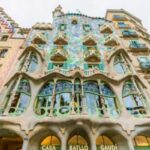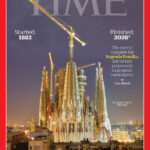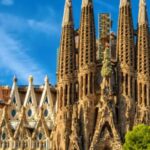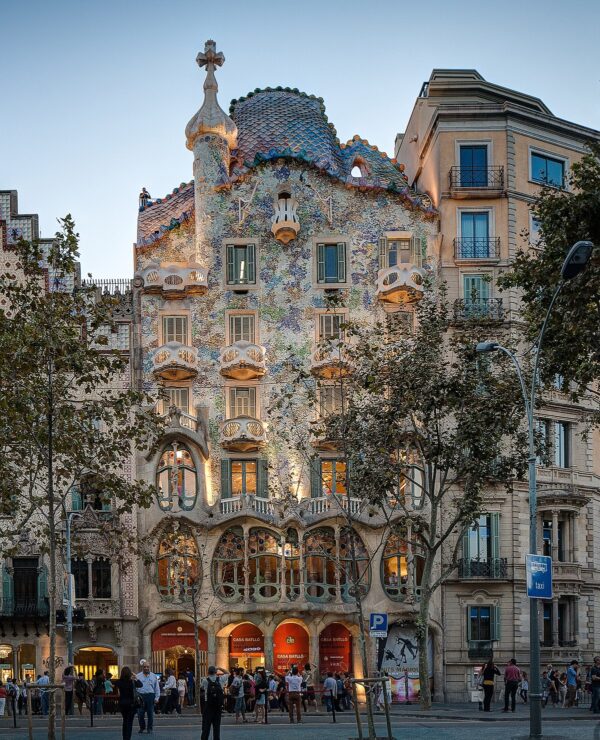
Casa Batlló stands as a testament to the genius of Antoni Gaudí, showcasing his unique approach to architectural design. This iconic building, located in the heart of Barcelona, captivates visitors with its vibrant colors, organic shapes, and intricate details.
Often referred to as a **Renowned masterpiece by Gaudí: Casa Batlló**, this extraordinary structure reflects the artist's deep connection with nature and his innovative use of materials. Its whimsical façade and imaginative interiors make it a must-see for anyone exploring the rich architectural heritage of Catalonia.
Exploring the Architectural Brilliance of Casa Batlló by Gaudí
Exploring the architectural brilliance of Casa Batlló reveals Gaudí's masterful ability to blend art and function. The building features a stunning façade adorned with colorful mosaics made from broken ceramic tiles, showcasing the artist's love for vibrant colors. The fluid lines and organic shapes mimic the forms found in nature, creating a sense of movement and harmony that invites admiration from all who pass by.
One of the most remarkable aspects of Casa Batlló is its innovative structural design. Gaudí employed advanced techniques such as a self-supporting stone facade and unique ventilation systems to enhance the building's functionality. Visitors can appreciate this ingenuity through:
- Sculptural balconies resembling the jaws of a dragon.
- Undulating walls that reflect natural light beautifully.
- A stunning rooftop resembling the scales of a dragon, complete with a cross that symbolizes Saint George.
The interior of Casa Batlló is equally captivating, with rooms designed to maximize light and space. The use of colorful stained glass and organic shapes creates a dreamlike atmosphere, making it a fascinating study for architecture enthusiasts. Each room tells a story, from the main hall's grand staircase to the enchanting attic space, all showcasing Gaudí's unparalleled creativity.
In summary, Casa Batlló is not just a renowned masterpiece by Gaudí; it is a celebration of architectural innovation that continues to inspire and educate. Its seamless integration of artistic expression with practical design sets it apart as a true icon of modernist architecture, firmly placing it on the map of architectural heritage in Barcelona.
The Symbolism Behind Casa Batlló's Unique Design Elements
The design elements of Casa Batlló are rich in symbolism, reflecting Gaudí's deep appreciation for the natural world. The façade is characterized by organic shapes that resemble marine life, evoking the feeling of being underwater. This connection to nature is further emphasized by the use of colors that mimic the vibrant hues of the sea and sky, creating a harmonious visual experience.
One of the striking features of the building is its balcony designs, which are often seen as reminiscent of bones or skulls. This choice serves to highlight the idea of life and death, emphasizing the cycle of nature. Gaudí intended for these elements to provoke thought and encourage reflection on the relationship between architecture and the environment.
Additionally, the rooftop of Casa Batlló plays a significant role in its overall symbolism. Shaped like a dragon's back, it is adorned with colorful tiles that represent the scales of a dragon, celebrating the legend of Saint George. This design element not only showcases Gaudí's creativity but also reinforces the connection between Catalan culture and the architectural identity of the building.
In essence, Casa Batlló is a masterpiece filled with meaningful details that invite viewers to explore its deeper significance. Each design choice contributes to a narrative that intertwines art with the natural world, making it a profound example of modernist architecture that continues to captivate audiences worldwide.
How Casa Batlló Reflects Gaudí's Mastery of Color and Light
Casa Batlló brilliantly exemplifies Antoni Gaudí's mastery of color and light. The building's façade is adorned with a mosaic of colorful ceramic tiles that refract sunlight in a myriad of ways, creating a dynamic visual experience. This interplay of color and light not only enhances the aesthetic appeal but also reflects Gaudí's deep understanding of how natural elements can influence architectural design.
Moreover, the interior of Casa Batlló is ingeniously designed to optimize natural light. Key features include:
- Curved windows that allow light to filter in from multiple angles.
- Stained glass panels in various hues, which transform sunlight into a vibrant spectrum of colors.
- Reflective surfaces that amplify the light, creating a warm, inviting atmosphere throughout the home.
The integration of light and color in Casa Batlló does not merely serve decorative purposes; it enhances the building's functionality. Gaudí's innovative use of light helps to create spaces that feel larger and more open, inviting residents and visitors alike to experience a unique ambiance. This mastery elevates Casa Batlló beyond a mere structure, transforming it into a living piece of art.
In essence, Gaudí's approach in Casa Batlló showcases his profound understanding of how color and light can convey emotion and meaning. Each element contributes to an immersive experience, inviting observers to engage with the architecture in a way that resonates deeply with the natural world, making it a true gem of modernist architecture.
A Historical Overview of Casa Batlló: Gaudí's Iconic Creation
Casa Batlló, completed in 1906, is one of Antoni Gaudí's most celebrated works, showcasing the architect's visionary talent in merging form and function. Commissioned by the wealthy Batlló family, this building replaced a previously existing structure, transforming the urban landscape of Barcelona. The innovative design reflects the *Modernisme* movement, a Catalan variant of Art Nouveau, characterized by its organic shapes and vibrant colors.
Notably, Casa Batlló's design was inspired by natural forms, which is evident in its facade that resembles the surface of a tranquil sea. Gaudí's use of curvilinear shapes and motifs inspired by marine life creates a sense of rhythm and fluidity, inviting visitors to explore the building from various angles. The roof, with its dragon-like spine, serves as a tribute to Catalan legends, adding layers of cultural significance to this architectural masterpiece.
The interior of Casa Batlló is a testament to Gaudí's attention to detail and functionality. Each room is designed to not only maximize light but also to promote a cohesive flow throughout the space. Unique features such as arched doorways and intricate woodwork enhance the overall experience, making it a fascinating study for architecture enthusiasts. Visitors can truly appreciate how every element was meticulously designed to serve both aesthetic and practical purposes.
Ultimately, Casa Batlló is more than just a building; it stands as a symbol of Gaudí's innovative spirit and his ability to invoke emotions through architecture. The integration of natural elements, cultural references, and artistic expression makes it a remarkable example of modernist architecture that continues to inspire awe and admiration in those who encounter it.
Visiting Casa Batlló: A Guide to the Must-See Features
When visiting Casa Batlló, one of the must-see features is the magnificent facade, which captivates with its flowing lines and vibrant colors. The façade is adorned with a mosaic of broken ceramic tiles that create a mesmerizing wave-like effect, reminiscent of the sea. This artistic approach not only showcases Gaudí's creativity but also invites visitors to appreciate the harmony between the structure and its surroundings.
Inside, the noble floor stands out with its detailed woodwork and stunning stained glass. Each room is designed to maximize natural light, creating a warm and welcoming atmosphere. The grand living room features intricately crafted ceilings and furniture, reflecting Gaudí's commitment to integrating art and functionality. Don't miss the impressive fireplace that serves as a focal point of the space, embodying the essence of modernist design.
Another highlight is the attic, which showcases a series of unique arches that resemble the ribs of a whale, reinforcing the natural motifs throughout the building. This area was originally used for drying clothes and now serves as a fascinating exhibition space where visitors can learn more about Gaudí's architectural innovations. The attic's design exemplifies how Gaudí transformed everyday spaces into extraordinary experiences.
Finally, make sure to explore the rooftop terrace, which offers stunning views of Barcelona along with its signature dragon spine design. The vibrant ceramic tiles and unique chimneys add a whimsical touch, reflecting Gaudí's imaginative spirit. Here, visitors can truly appreciate how Casa Batlló stands as a testament to Gaudí's genius, blending art, nature, and functionality in a way that continues to inspire awe.
The Influence of Nature in Gaudí's Casa Batlló Design
Antoni Gaudí's design for Casa Batlló is profoundly influenced by the forms and processes found in nature. The building's organic shapes mimic natural elements, creating a harmonious relationship between architecture and the environment. This seamless integration is evident in various aspects, including:
- Curvilinear forms that reflect the fluidity of water.
- Vibrant colors that evoke the hues of flora and fauna.
- Natural light that illuminates spaces in a dynamic way, changing with the time of day.
Gaudí's approach to design at Casa Batlló can be seen as an embodiment of the principles of biomimicry, where he draws inspiration from nature to enhance functionality and aesthetics. For instance, the building's facade is reminiscent of the ocean, with its shimmering scales and undulating surfaces. This connection not only beautifies the structure but also invites an emotional response from viewers, fostering a deeper appreciation for the natural world.
The interior spaces further illustrate Gaudí's reverence for nature, employing materials and designs that echo organic forms. The use of stained glass allows sunlight to filter through in a way that mimics the effect of sunlight filtering through leaves, casting colorful patterns on the walls. By incorporating these elements, Gaudí creates an immersive experience that blurs the boundaries between the built environment and the natural landscape.
In summary, the influence of nature in Casa Batlló's design is a testament to Gaudí's visionary genius. By harmonizing architectural innovation with natural inspiration, he not only celebrates the beauty of the environment but also encourages visitors to reflect on their connection to the world around them. This makes Casa Batlló a pioneering example of how architecture can resonate with the rhythms of nature.
 Casa Batlló Audio Guide: Explore Gaudí's Masterpiece
Casa Batlló Audio Guide: Explore Gaudí's Masterpiece The Official Website of Barcelona's Sagrada Familia: A Fascinating Glimpse into Gaudí's Masterpiece
The Official Website of Barcelona's Sagrada Familia: A Fascinating Glimpse into Gaudí's Masterpiece Compra tu boleto para la Sagrada Familia en Barcelona en línea o en taquilla. Evita filas y selecciona tu hora de visita.
Compra tu boleto para la Sagrada Familia en Barcelona en línea o en taquilla. Evita filas y selecciona tu hora de visita.If you want to know other articles similar to Renowned masterpiece by Gaudí: Casa Batlló you can visit the category WHERE YOU CAN GO.
Leave a Reply










Read more!